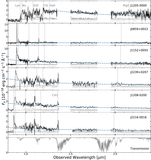Subaru High-z Exploration of Low-luminosity Quasars (SHELLQs). VI. Black Hole Mass Measurements of Six Quasars at 6.1 ≤ z ≤ 6.7
Abstract
We present deep near-infrared spectroscopy of six quasars at 6.1 ≤ z ≤ 6.7 with Very Large Telescope/X-Shooter and Gemini-N/GNIRS. Our objects, originally discovered through a wide-field optical survey with the Hyper Suprime-Cam (HSC) Subaru Strategic Program (HSC-SSP), have the lowest luminosities (-25.5 mag ≤ M 1450 ≤ -23.1 mag) of the z > 5.8 quasars with measured black hole (BH) masses. From single-epoch mass measurements based on Mg II λ2798, we find a wide range in BH masses, from M BH = 107.6 to 109.3 M ⊙. The Eddington ratios L bol/L Edd range from 0.16 to 1.1, but the majority of the HSC quasars are powered by M BH ∼ 109 M ⊙ supermassive black holes (SMBHs) accreting at sub-Eddington rates. The Eddington ratio distribution of the HSC quasars is inclined to lower accretion rates than those of Willott et al., who measured the BH masses for similarly faint z ∼ 6 quasars. This suggests that the global Eddington ratio distribution is wider than has previously been thought. The presence of M BH ∼ 109 M ⊙ SMBHs at z ∼ 6 cannot be explained with constant sub-Eddington accretion from stellar remnant seed BHs. Therefore, we may be witnessing the first buildup of the most massive BHs in the first billion years of the universe, the accretion activity of which is transforming from active growth to a quiescent phase. Measurements of a larger complete sample of z ≳ 6 low-luminosity quasars, as well as deeper observations with future facilities, will enable us to better understand the early SMBH growth in the reionization epoch.
- Publication:
-
The Astrophysical Journal
- Pub Date:
- August 2019
- DOI:
- arXiv:
- arXiv:1904.07278
- Bibcode:
- 2019ApJ...880...77O
- Keywords:
-
- dark ages;
- reionization;
- first stars;
- quasars: general;
- quasars: supermassive black holes;
- Astrophysics - Astrophysics of Galaxies
- E-Print:
- 20 pages, 10 figures, accepted for publication in ApJ
